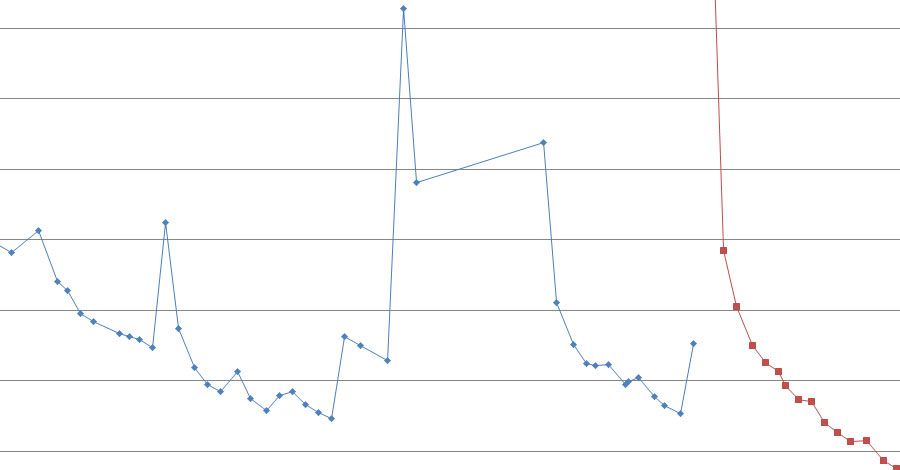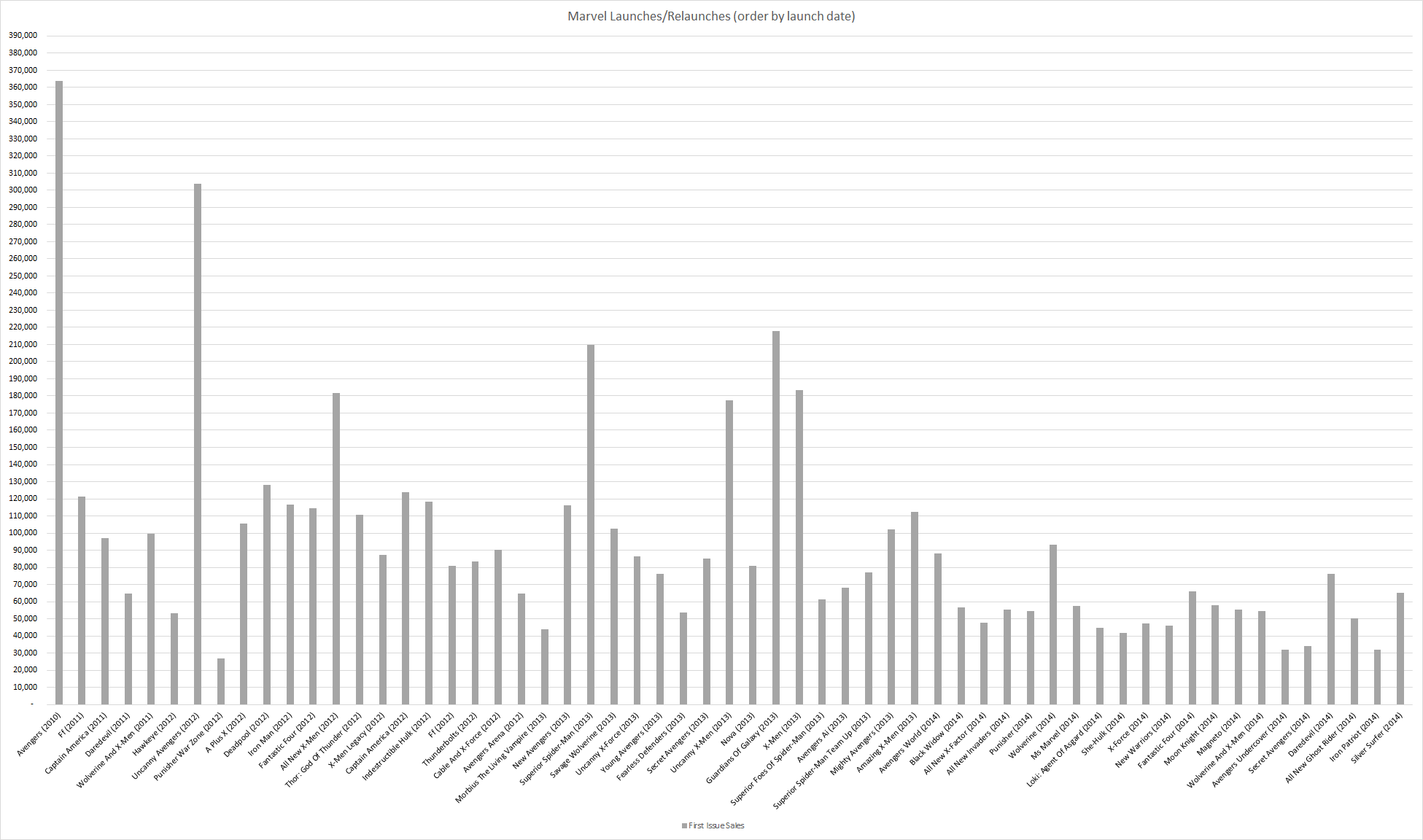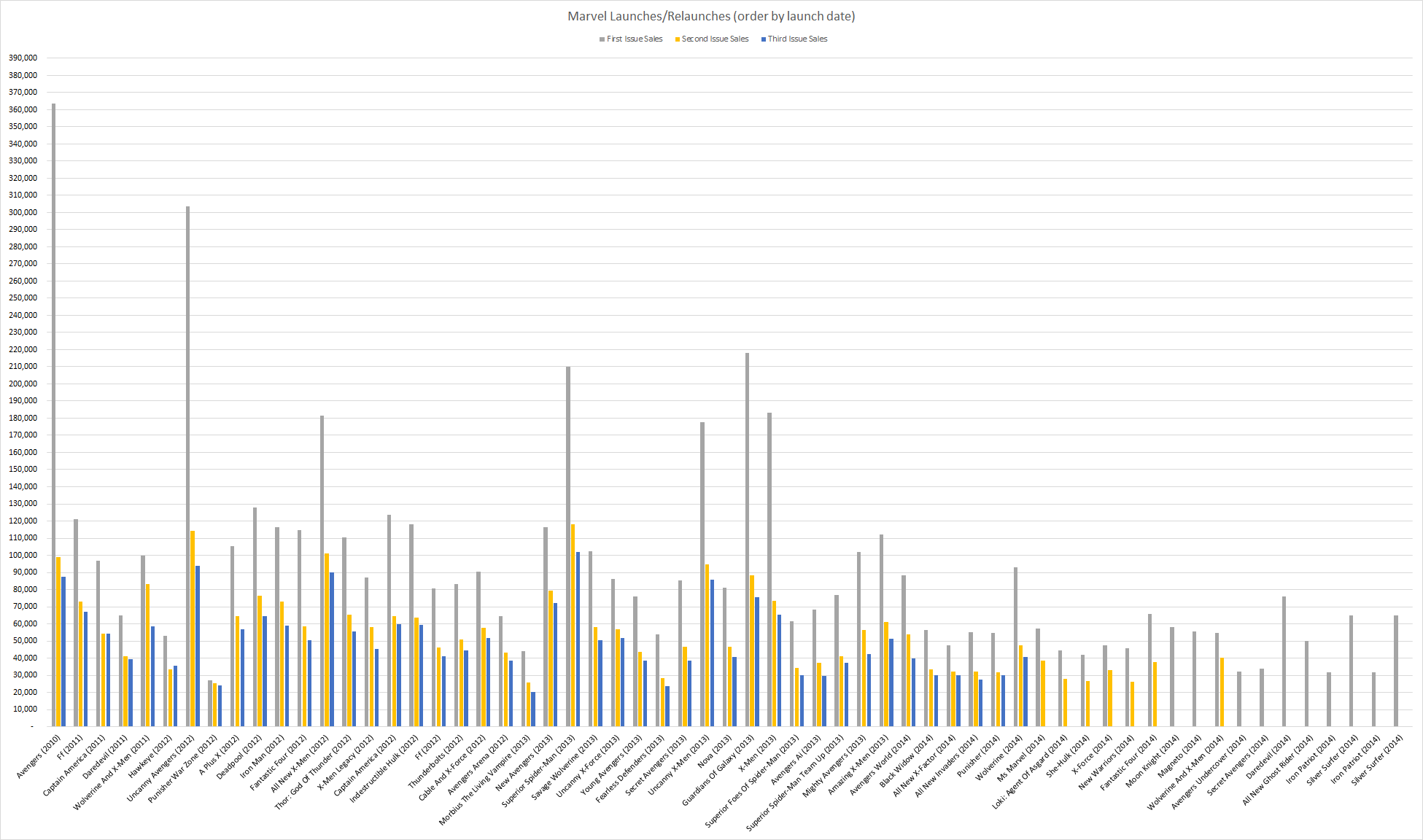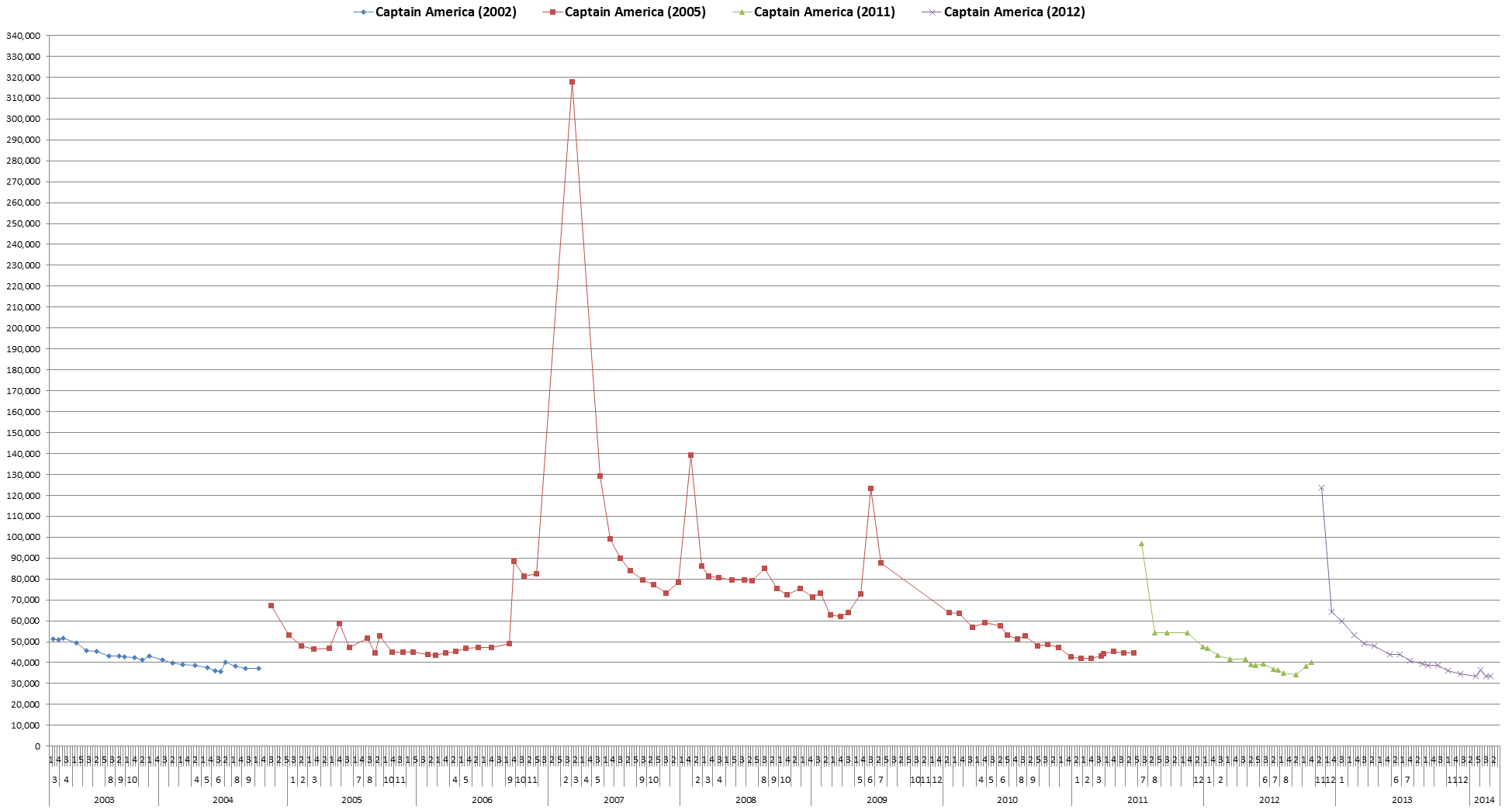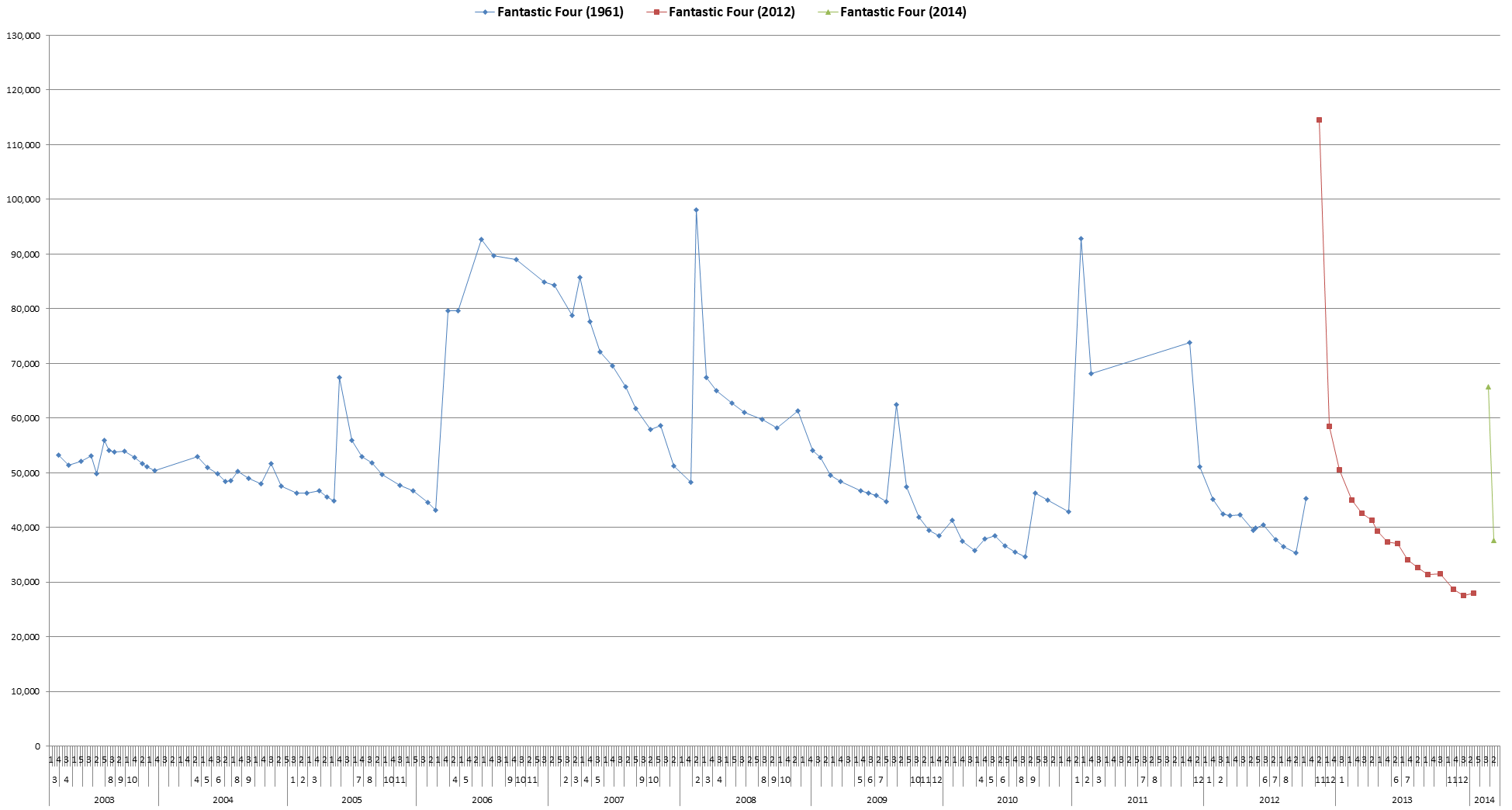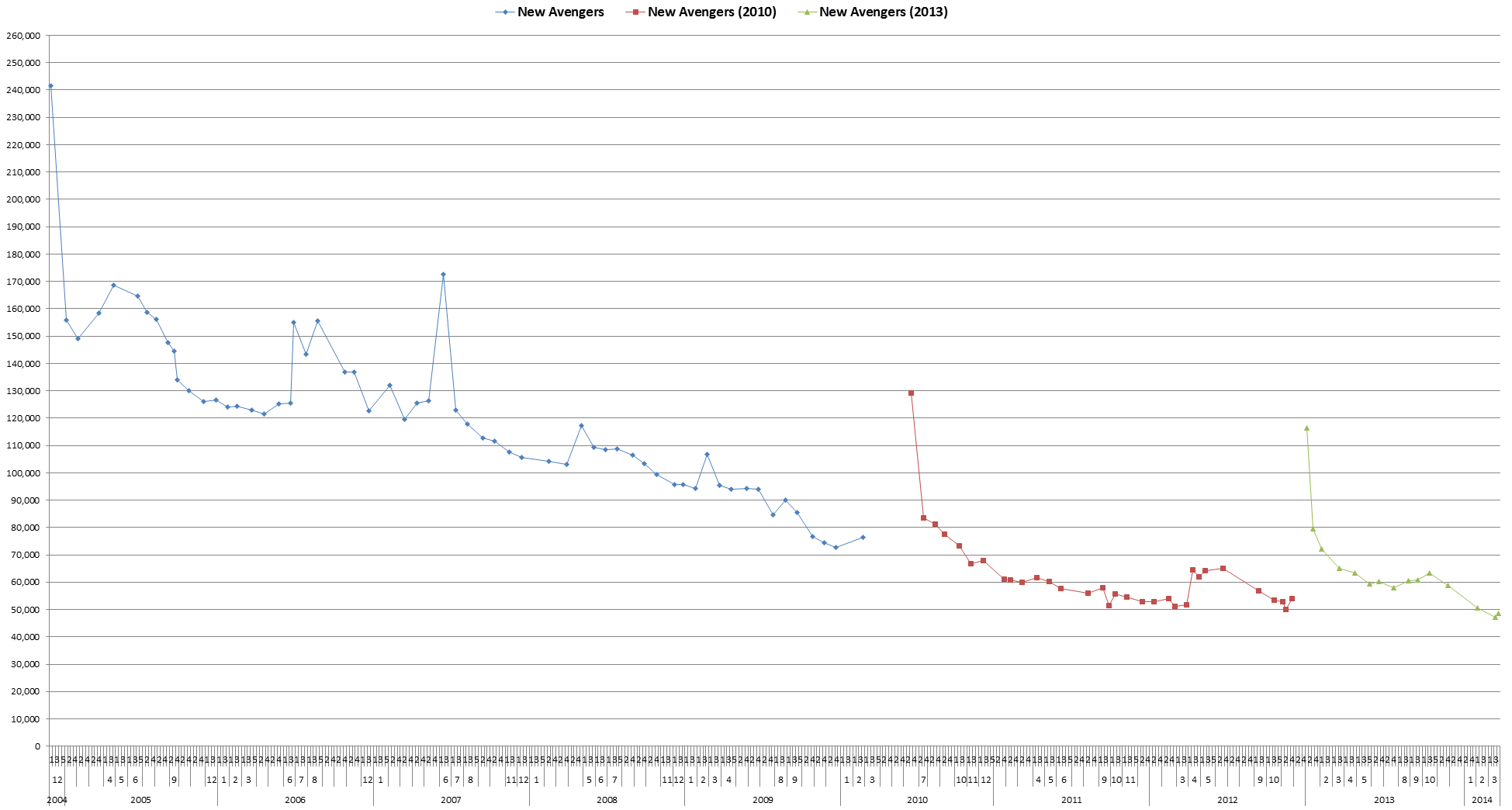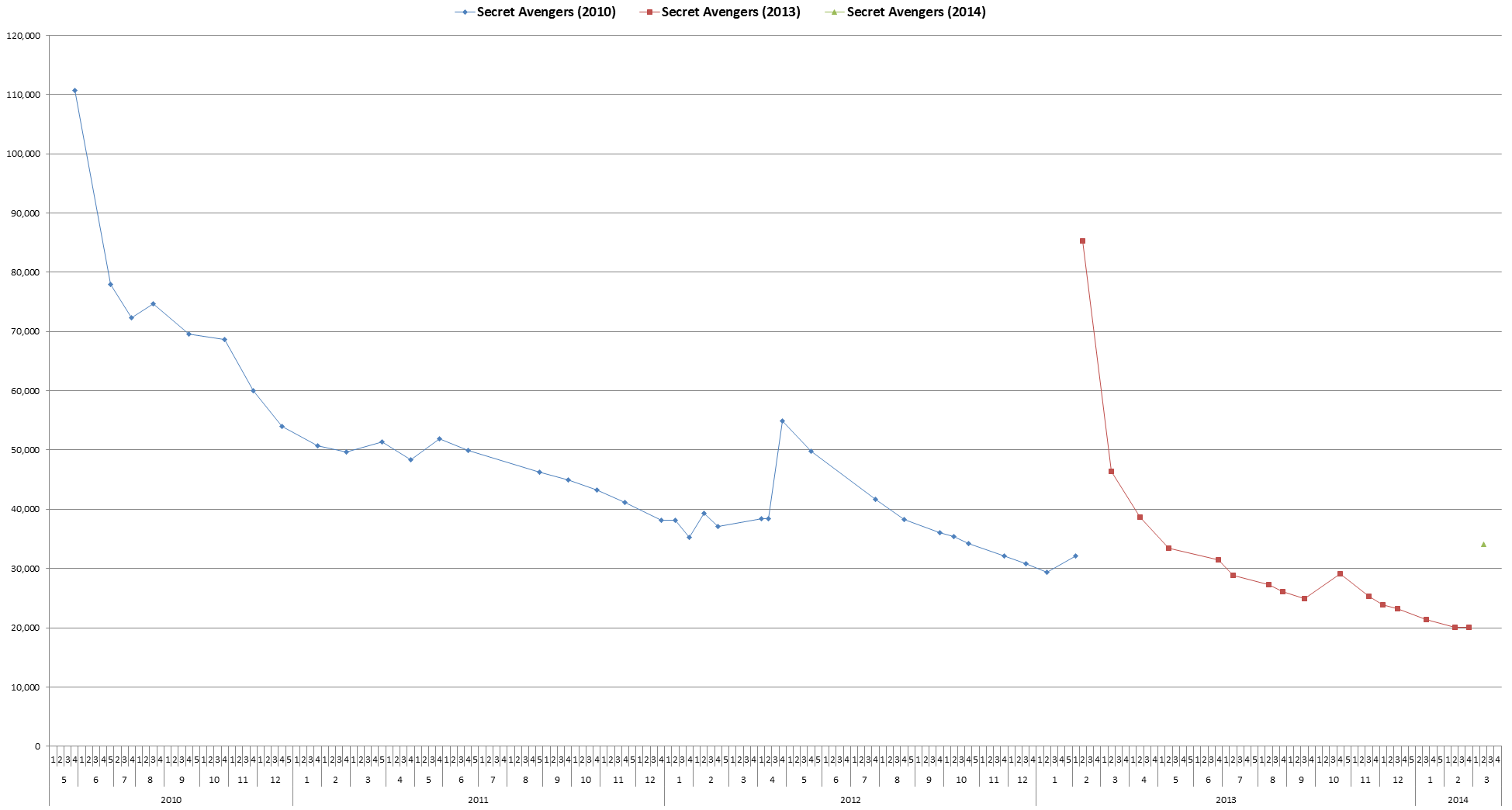With its August 2012 solicitations, Marvel Comics kicked off its Marvel NOW! initiative, which started shipping in October 2012. It was such a big deal, the publisher even relaunched the Marvel Previews catalog with a new first issue. Over the last year and a half, Marvel has launched a number of new titles while relaunching even more existing titles. Conventional wisdom is that first issues sell best, and since launches and relaunches seem to be a key aspect of Marvel's publishing plan, we're going to take a look and see if the approach is working.
Obviously, some relaunches involve changing the creative team, the line-up of characters, their status quo or some other fundamental change to the title. Other relaunches are more superficial, along the lines of just slapping a #1 on the cover. The question we're asking isn't if changing something about the title can improve sales. Hopefully, if a substantive change is made to the contents of a series, there should be a change in sales reflecting it, for better or worse. The question we have is if a relaunch, in and of itself, will increase sales.
The notion that first issues sell better than others has a couple of questions baked into it. What is a first issue? Does relaunching a title actually increase the sales of the title beyond the first issue? And, perhaps most importantly, can relaunching a title actually increase the sales of the title over the previous volume on a sustained basis?
The question of what a first issue is seems like it would be easy enough to answer: It is the issue of the title which ships before any other issue, usually with a #1 printed very visibly on its cover. By and large, this is a good definition. However, Marvel's various #0.1 issues start to cloud the issue, and the large #1 indicating new story arcs on recent Marvel NOW! titles also creates some confusion. For the purposes of this discussion, a first issue is simply any issue with #1 as the issue number, but the question does remain -- to what degree can an issue really be considered the first issue in any meaningful way if it is just a continuation of the previous volume, but renumbered with a #1?
Another thing which is usually a key aspect of a first issue is the promotional push the title gets with it. Not only do the first issues get a lot of press, they often come with a number of variant and retailer incentive covers. The marketing push increases potential interest in the title, and the plethora of covers increase the sales of the first issue. The question of what makes for a good first issue is a completely different topic which I won't talk much about here. Suffice it to say, for me, a good first issue introduces the characters and status quo for the title and gives the readers a sense of the tone and style of the series, enabling them to make an informed decision of whether they should continue buying it. Some of the Marvel first issues fit that description while a number of others fail to do so.
Here is a chart of the ongoing titles launched by Marvel since the start of the Marvel NOW! initiative, plus a few leading up to it. The titles are ordered by launch date, and the sales are the total known estimated sales, which includes both the sales during initial month sales and any reported reorder activity:
The first thing to notice is, while a few titles have launched very strong, most of the recent titles have launched under 90,000 units. "Wolverine" (2014) #1 launched with an estimated 93,142 units making it the strongest Marvel NOW! launch/relaunch so far this year. That will change soon since "Amazing Spider-Man" relaunches this week. Titles like "Uncanny Avengers" (2012) which launch at levels far above what any ongoing title is currently able to sustain are anomalies. The question here isn't if Marvel can launch titles over any given threshold, but how strong the typical relaunches are. With first issues normally setting the high water mark for sales on a title, the trend we see of first issue sales getting weaker is not good for Marvel.
Another thing to notice about the chart is how some titles are on it multiple times. The lifespan of volumes at Marvel is now better measured in months rather than years. With each relaunch, readers have a jumping off point. The theory is, more new readers will jump on than existing readers jumping off. After all, that is one of the core aspects of the conventional wisdom that first issues sell better.
Does relaunching a title actually increase the sales of the title beyond the first issue? This chart is the same one as above with the inclusion of the total reported estimated sales of the second and third issues (where available):
On average, the second issues sold around 59.02% of the sales of the first issue, and the third issue around 50.89% of the first issue. In a strange way, this seems to both decrease and increase the importance of those first issue sales. On the one hand, it decreases the important since almost half of those units are gone within two issues and therefore don't really count as a sustained increase in sales. On the other hand, because the average drop is by nearly half within two issues, the first issue sales are arguably more important since the higher the start point, the higher the series will settle after the drop. This second point is not reflected by the chart since the lower selling first issues tend to have correspondingly lower drops on the second and third issues. "Uncanny Avengers" (2012) had the highest first issue sales and largest second issue drop, while "Punisher War Zone" (2012) had the lowest first issue sales and the lowest second issue drop.
If anything, inflating the sales of a first issue though tactics like retailer incentive covers practically guarantees huge second and third issue drops. Based on the frequent relaunches, Marvel appears to be chasing that short term bump in sales from first issues, and is willing to relaunch titles on a yearly basis to do so.
To figure out if relaunching a title actually increases the sales of the title over the previous volume on a sustained basis, we need to see how the sales of different volumes of the same title compare.
"Captain America" is an interesting title to look at in terms of relaunches. Back in 2004, Ed Brubaker started a new volume of the series with the Winter Soldier storyline, which later involved the death of Captain America. As we can see from the chart, there were some huge bumps in sales reflecting substantive changes to the story content. We can also see how the later relaunches did not significantly impact sales in and of themselves beyond the bumps on the first issues. Even in the cases where there was an increase in sales, it didn't take long for the title to gravitate back to the 40,000 to 50,000 units it was selling in 2003. Keep in mind that with these relaunches there were changes to both the creative team and the story content of the title. Had those same changes taken place without relaunches, the only likely difference would be the lack of the first issue bumps.
The chart for the "Fantastic Four" illustrates the sharp increases and subsequent attrition typical of many titles. A new creative team or dramatic story shift can create a sudden surge in interest for the title, followed by months of diminishing interest until the cycle repeats itself. In this case, the death and later return of a member of the Fantastic Four and the media blitz around those story points caused a number of the peaks in the chart.
"Ghost Rider" is a fascinating case because of the time gap between some of the volumes. While it is too soon to know the magnitude of the second issue drop on the volume which just launched, based on past history, the title will likely fall below 30,000 units in short order. This sort of clear trending across volumes is not uncommon.
"New Avengers" is another case in which the trending across volume indicates relaunches have a negligible impact beyond the first issue bumps.
The chart for "Secret Avengers" illustrates how a new volume can start off selling multiple times the sales the previous volume ended at, only to return to that same level within a few issues. The bump on the first issue is impressive. The increase on the second and third issues of the 2013 volume are much more in line with the increase in sales sometimes seen at the start of story arcs. Often, the beginning of a story arc is seen as one of the few jumping on points for an ongoing title after the first issue. With many Marvel titles only lasting two or three story arcs, readers might start only considering sampling a title when it launches.
While conventional wisdom is first issues are a viable and successful way to increase sales, the data indicates otherwise. Though there is normally a significant bump in sales on the first issue, the gain is usually lost within a few issues, with the title returning to the level it sold at before the relaunch. There is no evidence supporting the idea that relaunching a title with a new first issue increases sales in and of itself. Combining a relaunch with a creative team change or major changes to the storyline can result in an ongoing increase in sales, but there is strong evidence to indicate that sales would have gone up had the previous volume continued, as illustrated in the "Captain America" chart. The renumbering is sometime coincidental with a sales increase rather than the cause of it.
In addition to not being a successful way to increase sales, the tactic doesn't seem to be viable over the long term. The more recent relaunches at Marvel are coming in at lower sales levels both because of how recently some of the previous volumes of those titles launched and because of the number of new first issues at Marvel these days. A new first issue a month might be viable, but one or more a week clearly isn't. "Wolverine and the X-Men" launched with 99,611 estimated units in 2011 and with only around 54,675 units when it relaunched in 2014. "Fantastic Four" launched around 114,531 units in 2012, relaunching at a far lower level in 2014 with only 65,775 units. "Secret Avengers" launched at 85,267 units in 2013 and at just 34,035 estimated units in 2014. Launching with lower numbers on the more recent volumedoesn'thappen universally, but it has become the norm, not the exception.
Marvel has gone to the well too often and too frequently. The lower launches are setting lower high water marks for the relaunched titles. With the number of new titles they are launching, the launch numbering most likely will continue to weaken on most title. Marvel is systematically draining the sales power out of first issues much like it drained it from retailer incentive covers. A few years ago when Marvel first did the zombie variant covers they routinely boosted sales by 5,000 to 7,000 units. Now, with themed covers being a monthly occurrence, the bump is much smaller, even as we're seeing diminished returns on the first issues. Much like the variants, as more and more first issues are released, they continue to become less and less special, resulting in lower and lower launch numbers. Obviously, there will be some high profile launches which do well -- "Amazing Spider-Man" for example -- but those cases reflect actual changes to the contents beyond simply renumbering the series back to a first issue.
Another unintended consequence of the repeated relaunches is, it makes recommending past story arcs increasingly challenging. Individual issues are available digitally on comiXology, the Marvel app and Marvel Digital Unlimited. It is no longer possible to easily point a casual reader in the direction of a good story arc with just a title and an issue number. Explaining to a casual reader which issue of "Captain America" starts the storyline which is the basis for the "Captain America: The Winter Soldier" movie requires referencing volumes, creators and story arc titles. One volume too early, and they get the "Enemy" arc by John Ney Rieber. One volume too late, and they get Ed Brubaker's "American Dreamers" arc instead of "Out of Time." Unfortunately, that bell can't be unrung.
Relaunches are usually the result of weak sales. Downward sales are caused by perceived shortcoming in the content and have nothing to do with the issue number. Downward trends on a title often continue onto the next volume, even if that next volume temporarily reset sales at a higher level. Instead of propping up sales of titles with new first issues and retailer incentive covers, the way the stories in the individual comic book issues are told is what needs to change. Are the issues accessible to new readers? Do readers finish the issues feeling like they read something whole, or do they feel like they only got an incomplete fragment of a story? Maybe more pages are needed for the current storytelling style? Whatever the case, odds are, the solution to declining sales has more to do with the content of the issues than the issue numbers on the covers.
If you'd like to listen to in-depth discussions of the sales data, check out the Mayo Report episodes of the Comic Book Page podcast at www.ComicBookPage.com. As always, if you have any questions or comments, please feel free to email me at .

